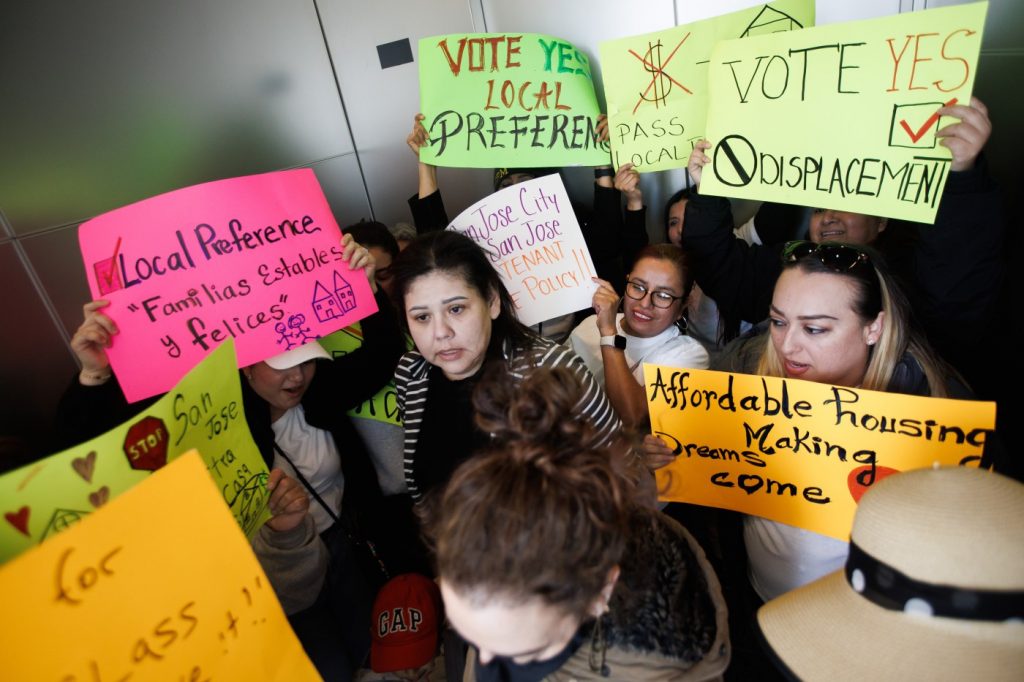Each year, thousands of San Jose residents apply for affordable housing, but only a tiny fraction land a low-income apartment.
To give many of the city’s most vulnerable renters a better shot at a unit, local officials are weighing whether to reserve a portion of San Jose’s cost-restricted rentals for those from neighborhoods where people are most likely to be forced out because of high housing costs.
The proposed policy would set aside 20% of apartments in new city-funded affordable housing projects for low-income applicants from high-displacement areas. It would also commit 15% of such units for applicants who live in the same neighborhood as a newly constructed complex.
On Monday, the city’s Community and Economic Development Committee unanimously agreed to send the proposal to the City Council for a vote set for March 26.
Many cities across the Bay Area, including Oakland and San Francisco, already reserve affordable units specifically for their own residents. But San Jose’s focus on preventing displacement makes its proposal unique.
The proposal comes as Google prepares to build a massive mixed-use neighborhood west of downtown, which has sparked concern among some long-time residents that housing costs will spike and they will be forced to leave.
For decades, working families have left San Jose as rents skyrocketed and the city struggled to build anywhere near enough affordable housing. A typical market-rate one-bedroom apartment in San Jose now goes for $2,359 a month, compared to $1,207 nationwide, according to rental listing site Apartment List.
“I’ve seen friends, family members, and colleagues moving to other cities and farther away from the place that we all have called home due to the high cost of living,” said Peter Ortiz, a councilman and committee member, at a rally with tenant advocates before Monday’s committee meeting. “Many of these people I call family often work two jobs just to make ends meet and sometimes have to choose between either paying rent or feeding their very own family.”
By analyzing research from UC Berkeley’s Urban Displacement Project, San Jose estimates more than 55,000 low-income households are in a neighborhood where residents are at high risk of displacement. The large majority live in and near downtown or in East San Jose.
However, since the new policy mainly would target new affordable housing projects, just a few hundred apartments currently in the construction pipeline would be available to those households, city officials said. Existing city-funded projects would only fall under the proposal if and when local officials update a property’s affordable housing agreement.
To qualify for an affordable apartment, a household must earn less than 80% of Santa Clara County’s median income. That’s $96,000 for a single person and $137,100 for a family of four. Eligible applicants would enter a lottery for the available units.
Going forward, how many units could be covered depends on the number of low-income homes the city can help build in the future.
Mathew Reed, director of policy at the South Bay pro-housing group SV@Home, said that while the city currently appears committed to affordable housing, that could always change should city budgets fluctuate or local politics shift.
“The level of resources the city will have over the next five years to build affordable housing is contingent on a number of factors that are hard to predict,” Reed said.
Related Articles
A young couple searches for a first home in the Bay Area. What could they get for $500,000?
‘Beauty will save the world’: Tent City Barbers gives hope to Bay Area’s unhoused
California homeownership at highest level since 2010
Sen. Padilla rekindles Housing for All Act, tackling homelessness and housing affordability
Los Gatos council delays Housing Element again to review state feedback
But he pointed to a Bay Area housing bond measure expected for the November ballot that could raise as much as $20 billion for the region as a way to create potentially thousands of new low-income apartments in San Jose alone.
For Yolanda Cassas, a grandmother whose multigenerational family was forced out of San Jose by soaring rent prices, more affordable housing can’t come soon enough. She now shares a five-bedroom house in Milpitas with two other families who can barely cobble together enough for the $4,800 monthly rent.
“The rent is expensive, the food is expensive, everything is very expensive,” she said.


